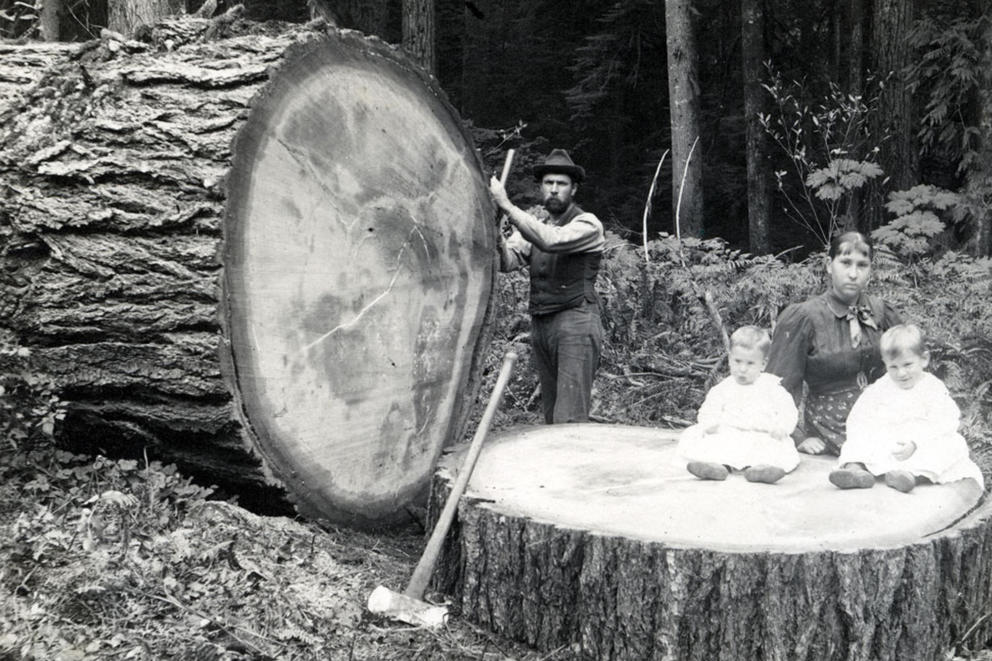Known for our forests, the Northwest also had appeal for its moderate climate and fertile land. Indigenous people had been cultivating crops and game, with periodic burnings to promote the growth of berries, camas root, and oak prairies.
When Euro-American settlers poured into the region, they were dazzled by the forests, which they proceeded to chop down for lumber to build with and to sell.
Cleared areas for cultivation were comparatively scarce, so homesteaders sought to raze the forests for farm and grazing land. But that often left them with fields of stumps. Massive stumps. Endless stumps.
These rugged allotments were called “stump farms.”
You know those souvenir postcards showing giant fruit or potatoes or ears of corn on flatcars? They were a joking way to show off a region’s pride in its abundance. Here, we didn’t need faked photos. Real photos of real trees and their stumps showed what the pioneer class faced: trees so big they could only be felled one or two stories above the ground by loggers with whipsaws and axes standing on springboards. You still can see some of those notches on old-growth stumps today.
The logs and stumps from mammoth firs, spruce and cedars became trophies of pioneer-era industriousness. While we might weep over these fallen giants today, postcards and images once featured people standing next to felled big timber much like someone might pose with a record-sized fish — or leviathan.
As forests came down, vast fields of stumps could not be easily removed. What do you do with stumps of trees so huge and so deeply rooted in the soil?
You could burn them; you could dig, chop, and pry them out; or haul them out with horse or oxen.
Some took a shorter route: dynamite.
An exploding stump could be dangerous. Dexter Horton, a Seattle pioneer and early banker, is said to have stopped by a stump being burned. He decided to warm himself by the fire. Suddenly the stump exploded and launched him and his overly warmed backside through the air. Perhaps a lesson was learned: Horton recovered and later built a fireproof bank that survived the great Seattle Fire of 1889.
Stumps were not unusual in growing frontier cities. Portland was nicknamed “Stumptown” during its expansion in the mid-1800s. Portlanders are said to have hopped from stump to stump to avoid the mushy rain-soaked ground — a kind of improvised boardwalk, I guess.
Ingeniously, settlers found uses for some of the larger stumps. One in the Olympic Peninsula’s Elwha country was turned into a post office in the 1890s. Another in Tacoma’s Wright Park had stairs installed and became a kind of observation platform.
People danced on stumps, played music on stumps, performed acrobatics and posed for family photos on stumps. Near Olympia, some enterprising guys turned a giant stump into a barn for their livestock.
Massive cedar stumps often had hollow or soft interiors at the base. Why let them go to waste? Why not carve out some space and move in? In Vancouver, B.C., someone built a three-room stump house. Much easier than throwing up a log cabin!
The most famous stump dwelling was the Edgecomb house in Snohomish County near Arlington. It was hollowed out by the Lennstrom family, Swedish immigrants who moved west. They put a roof on, installed a window and a stove. They used it as a temporary home until they could build a more permanent one.
Photographers, including the prolific Darius Kinsey, took pictures of it, and they sold as postcards. You could say that in the early 20th century the Edgecomb stump house went viral. It was eventually dismantled and lost to old age. There’s still a stump house in Arlington, though, that stands at the Stillaguamish Valley Pioneer Museum.
A spectacular kind of stump house was shown at the Pan-American Exposition in Buffalo in 1901. It was a hollowed-out fir from Everett that stood 10 feet high and 13 and a half feet in diameter and could hold 65 people! The scale dazzled visitors who learned that Washington boasted of “inexhaustible” forests.
Even more exotic was a multistoried stump house with a spiral staircase planned for the 1909 Alaska-Yukon-Pacific Exposition in Seattle. It was never built, but offered a kitchen, porch, living room, fireplace and, of course, cedar flooring, along with the old-fashioned woodsy fragrance of pioneer days. Alas, such fairs often promise more than they deliver, so there are no flying cars to fly you to your luxury stump house.
Back in the day, a shorthand way to say the Northwest was a remarkable place was to feature a stump so big you could live in it. A stump house could make our rainy region seem habitable — even cozy — as if we were mossy hobbits living in a landscape of forest giants, even while we were chopping them down.
For more on this story, listen to the Mossback podcast:





